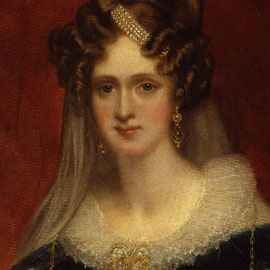 Born in Germany in August 1792, the woman who went on to become Queen Adelaide was christened Amalie Adelheid Louise Therese Karolina Wilhelmina. She was more than a quarter-century younger than her future husband who was born in August 1765. Queen Adelaide lived until she was 57 years-old (she died in 1849) while King William reached the age of 72, dying 1837.
Born in Germany in August 1792, the woman who went on to become Queen Adelaide was christened Amalie Adelheid Louise Therese Karolina Wilhelmina. She was more than a quarter-century younger than her future husband who was born in August 1765. Queen Adelaide lived until she was 57 years-old (she died in 1849) while King William reached the age of 72, dying 1837.
Adelaide was a pious woman, and was modest, charitable and dignified. Passionate about children and their rights, she was a driving force behind the abolition of slavery in England. It’s reputed, also, that Adelaide was the person responsible for the introduction of the idea of Christmas trees to the English.
Having lost her father, George I (Duke of Saxe-Meiningen) at a young age, Adelaide had a strong female upbringing. She was well-educated and taught the finer details and subtleties of royal and diplomatic life very early on.
To maintain the desired royal lines, it was arranged for Adelaide to marry William, Duke of Clarence, the wedding taking place in England in July 1818. The pair had only recently met. A frugal woman, she had her coronation crown manufactured at her own expense.
William already had ten children to Irish actress Dorothea Jordan. The children were known as the FitzClarences, the prefix ‘Fitz’ denoting that they were illegitimate offspring. Still, as stepmother, Adelaide invested great time and effort into the children, helping to further the careers of the eldest, and taking on the responsibility of educating the younger children. It was Adelaide’s insistence that a portrait of their mother hang in the home.
William was considered to be a buffoon, but during their marriage Adelaide helped improve his behaviour considerably. Together they lived a very simple life, and were even considered to be quite dull – was she the original boring Adelaide?!
Unfortunate in producing children with the king, Adelaide suffered multiple miscarriages, eventually bearing a daughter, Princess Charlotte, who did not survive infancy. Adelaide was very fond of her niece, Victoria, who would go on to reign as Queen (from 1837 to 1901). King William reigned with his consort Adelaide for seven years, and most likely with her help, restored the respectability of the monarchy.
On her death, she left a sum of money and certain memorabilia to the public authorities of South Australia. This includes her autographs, a facsimile of her own directions for her funeral, a personal pocket handkerchief, envelopes of autographs of the late members of the Royal family, letters of George IV, autographs of various crowned heads of Europe, letters of the Duke of Wellington and a letter of Lord Nelson’s to the Duke of Clarence, autographs of King William IV, letters written to her by European sovereigns, two cameos of King William IV and Queen Adelaide, several volumes of books bearing her autograph or her Royal Arms. Her funeral directions required that she be carried to her grave by sailors “in peace, and free from pomp and vanity.”
Footnote [updated as per Sharon’s comment below]: In Adelaide, South Australia, a bronze statue of Queen Adelaide by sculptor Lindsay Daen stands proudly in the foyer of the Town Hall. It was unveiled in 1980. The Queen Adelaide Club provides an exclusive social club for women. Meanwhile, each year the Queen Adelaide Society Inc celebrates Queen Adelaide’s birthday (August 13) with a tea party held in the Queen Adelaide Room of the Town Hall. Everyone who bears the name ‘Adelaide’ is invited to attend as an honoured guest.

13 Responses
I really enjoyed reading about Queen Adelaide. I’m sorry to say I really knew nothing about her nor have I seen her statue in tbe Town Hall. I m8ght go and check it out and say hi to Adelaide.
Hi Janine, thanks for the comment. Sad to say, until I went looking for the information, I was oblivious to all about Queen Adelaide (except for knowing that Adelaide was named for her). As the namesake of our city, I think she should be covered in SA schools as a matter of course – I’m pretty sure we never learned about her ‘in my day’, and I’m guessing that’s still the case. I’d be interested, if you could ask your kids, if they know much about our Queen. Cheers, Colin.
It took a bottle of Queen Adelaide Australian Tawny to light the spark of curiosity as to whether Queen Adelaide ever existed and who she was. The drawing on earlier labels depict her as a real stunner. Suspecting the city of Adelaide must have been named after her, I have now found out, and thank you for the education. I was raised in Victoria and apparently Australian history is kept very vague, even back to Empire days of the 1950’s in primary schools. Admittedly I never was a student of history even through my secondary years. Peter Holt
But I do think everybody should know a little bit about Australia following their educational upbringing. Peter Holt.
Hi Peter. Indeed, she was quite a likeable woman from what we’ve read; earnest, dutiful, strong. I wish there was more time spent on delving deeper into interesting people like Queen Adelaide in school because I am sure it would build more empathy between kids and these stories of the past. Thanks for leaving a comment or two. Steve
What a revealing description, thank you. I read this after researching the name of the sculptor of the bust of Queen Adelaide from a general knowledge quiz in SA Weekend today. She was certainly an admirable woman and her ideas were and are still important and visionary. I will make sure my children and grandchildren know her history. Thank you. Wendy
Poor woman gave birth to babies who died.
I’m blood-related to both: King William IV of the UK as his fourth cousin six times removed six times removed six times removed (4C=6×R)
and am related to Queen Adelaide of
Saxe-Meiningen as her fifth cousin seven times removed (5C×7×R). I was also born in Meiningen, Thüringen, in Germany in June 1946.
Hello Maria, what a small world it is to enable such a connection. Thank you for saying hello. Steve.
I would like to inform you about the Queen Adelaide Society Inc, as opposed to the Queen Adelaide Club, which is very exclusive and requires an invitation to join.The way you have written your article makes it seem that the Adelaide Club hosts the birthday tea in the Town Hall each August 13th.
The Lord Mayor is our patron, and they host the Mayoral Birthday Morning Tea on Queen Adelaide’s birthday each year for OUR members and children named Adelaide.
As a society we raise funds each year through events and make a donation to a South Australian children’s charity in the name of Queen Adelaide. Our membership is $10 and anyone can be a member
Lovely, thank you for that, Sharon. I have tweaked that last part for Colin. Steve.
Thanks, Sharon. I appreciate the clarification. Colin
In our Bible Museum in St Arnaud’s collection of royal memorabilia we have 2 postcards that were handwritten by Queen Adelaide. These cards have Bible quotes on them, together with her initials. We also have a very large Bible that is a copy of one that was commissioned by King Willim IV.